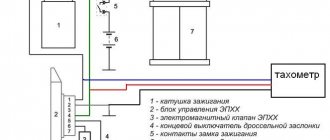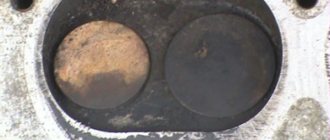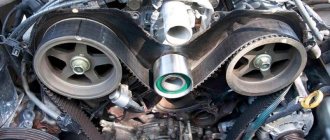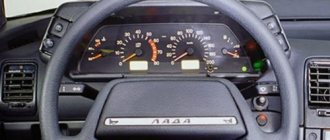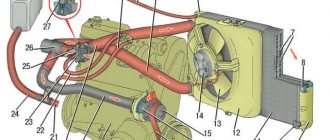Developers of modern cars are constantly improving engines to improve their environmental component. The USR system is one of the mechanisms that allows minimizing toxic emissions into the atmosphere by returning part of the exhaust gases to the combustion chamber, while the operation of the diesel engine becomes “softer”. When operating a power unit with EGR, many car owners experience breakdowns or malfunctions of the recirculation system. A new replacement part is quite expensive, but it can be cleaned, repaired, or the system simply turns off.
How does the USR work on a turbodiesel?
The main function of the EGR system is the partial return of exhaust gas to the intake manifold for the purpose of afterburning. On a diesel engine, this solution allows for softer and smoother operation of the engine, which improves its performance and reduces fuel consumption, and the exhaust reduces its toxicity. The appearance of exhaust gases in the intake does not change the ratio of the main components of the combustible mixture, power is not lost in different operating modes, and fuel is saved.
The principle of operation of the USR valve on diesel engines is the connection of part of the exhaust gases with air entering through the intake manifold. Engine exhaust contains nitrogen oxides due to increased heating of gases in the combustion chamber. When the EGR system is activated, combustion occurs at a lower temperature, and the level of harmful substances in the exhaust becomes lower. On diesel engines, the valve opens automatically at idle, and closes under load and maximum power.
Why jam and is it worth doing?
When wondering why to make a plug and whether it will lead to disastrous consequences, it is worth considering a little theory. If the recirculation system does not operate properly, it is necessary to replace not only the valve, but also clean other parts. Such repairs are expensive and will be required again after a certain time. Bad fuel creates a deposit of combustion residues. If the car is used quite intensively, then within a few months after the repair, malfunctions will be noticeable. In addition to low-quality fuel, the functionality can be disrupted by:
- wear of the cylinder-piston group;
- faulty sensors;
- breakdowns in the turbocharger;
- disturbances in the ventilation system.
The USR system often becomes dirty and cannot effectively perform its function.
As we can see, the USR system is very demanding and often fails on diesel engines. On most models, it is responsible only for the amount of harmful emissions and does not affect the technical parameters of the car. A competent plug will allow you to forget about problems with the USR valve and even slightly improve the efficiency of the power unit. But before starting such work, you should still consult a car service center and find out the features of the plug specifically for your car model.
Why do you turn off the EGR valve?
During long-term operation of a diesel engine equipped with an EGR system, car owners often experience a decrease in power and the appearance of exhaust smoke. Fans of engine tuning claim that gas recirculation “strangles” the power unit, preventing it from displaying its full power potential. Based on similar arguments, many drivers decide to turn off the EGR system. This procedure involves turning off the recirculation system, which should theoretically increase power.
There is an opinion that the rapid formation of carbon deposits on the USR valve and the intake of exhaust gases into the intake manifold provoke increased carbon formation and coking of the combustion chamber. A malfunction of the USR system associated with valve failure leads to excessive fuel consumption and unstable engine operation. Resins and soot enter the combustion chamber, due to which diesel oil quickly oxidizes and the overall service life of the power unit is reduced.
The need to disable the USR appears after a mileage of 80-120 thousand km, because the presence of such mileage causes a certain wear and tear on the engine. Exhaust gases redirected inward have a high degree of pollution. After they are further mixed with crankcase gases, a thick layer of tarry deposits appears in the intake manifold, EGR valve and engine head valves. A clogged system causes errors to appear and can cause the car to suddenly go into emergency mode.
Removing the diesel particulate filter
In many cases, along with turning off the USR, the particulate filter is removed. This is due to the fact that after the valve is plugged, the content of harmful impurities in the exhaust gas flow increases. The exhaust system element quickly becomes clogged and fails.
A dirty particulate filter leads to:
- reduction in engine power;
- excessive increase in oil level;
- increased fuel consumption.
Frequent active regeneration has a detrimental effect on the service life of the power unit. A breakdown may even occur that requires urgent repair.
Oil getting into the intercooler and cylinders is highly likely to cause uncontrolled combustion. This will lead to critical damage to the motor.
Removing the particulate filter helps avoid the above problems and the costs of servicing and replacing this element of the exhaust system.
This stage of vehicle performance optimization includes:
- particulate filter compartment;
- cutting out a special hole;
- matrix extraction;
- welding the structure and installing it in its proper place.
Next comes the controller firmware. This event leads to the normalization of vehicle operation in the absence of a particulate filter.
USR malfunctions on diesel engines
The USR valve is a part that performs a bypass function, which either passes part of the exhaust gases from the manifold into the supply line, where they are mixed with air (if in good condition), or not. If the valve malfunctions, the ECU will display a corresponding error on the dashboard indicator. Malfunctions of the USR on a diesel engine may include the following:
- Carbon deposits in the system that affect the EGR valve and plate. Excessive carbon formation occurs when the engine is operated on low-quality fuel, incomplete combustion of the fuel mixture, or a violation of the crankcase gas exhaust system.
- The valve is clogged, causing it to jam when opening or closing, or incorrect operation in the form of untimely operation, which is noticeable when the engine is idling.
USR malfunctions manifest themselves in frequent engine stops, floating speed in idle mode, tripping, jerking while driving and a drop in power during acceleration.
It is possible to identify a breakdown of the recirculation system by visually inspecting the condition of the pipelines and sensor connectors. Accurate diagnostics include electronic scanning and other procedures that check the functioning of the actuators and the EGR valve.
Positive and negative sides
Experts call the main disadvantages of the USR system:
- Loss of engine efficiency.
- Increased amount of solid parts due to exhaust gas reuse.
- Resins and abrasives get into the combustion chamber, which over time has a bad effect on the operation of the diesel engine.
At the same time, the main function of the USR is to reduce the total amount of harmful emissions into the atmosphere. Unfortunately, due to the rapid failure of the system due to contamination of the valve and sensors, it cannot operate effectively for a long time. Most mechanics recommend turning off the EGR. But you should make sure that it is in the closed position. Otherwise, when the USR is turned off, most of the gases will return to the intake, which will lead to unstable operation of the diesel engine.
To improve the performance of the diesel engine and not spend money on repairing the USR system every time it breaks down, we recommend making a valve plug. In most models, this can be done independently, saving on the services of a service center. Before starting work, you need to make sure that shutting down will not lead to engine malfunctions.
USR repair on diesel
Repair of the EGR system consists of mechanically cleaning it from carbon deposits and deposits using a small metal brush and rinsing with a “WD” cleaner, which is designed to remove deposits and rust from metal. At the end of the procedure, wipe the inside of the valve with a rag soaked in solvent. Repairing the USR on a diesel engine also includes cleaning the solenoid (if there is one), which serves as a filter element that prevents debris from entering the vacuum system.
Flushing the USR valve from burning is carried out after removing it, treating it through the holes with a special aerosol used to clean carburetors, then the part is placed in a container filled with lighting kerosene. Then they disassemble it by unscrewing 4 bolts and clean it from the inside. This service will eliminate signs of EGR valve failure and restore it to proper operation. The procedure should be carried out regularly after 60-100 thousand kilometers.
EGR valve malfunction.
Problems with the recirculation system are characterized by various symptoms. The following are the main signs indicating possible problems with the EGR valve:
- when accelerating, the car moves jerkily;
- There is vibration at idle;
- the engine loses power;
- The “Check Engine” emergency engine control software icon is on;
- exhaust gases have an increased level of nitrogen oxides;
- the exhaust is painted black;
- there is a high consumption of gasoline or diesel fuel.
The breakdown of the recirculation system can be due to many reasons. The most common of them are described below.
The valve mechanism is jammed.
The most common reason for the EGR valve not working is the jamming of its mechanical part. This happens when it is open or closed, depending on the specific situation:
- in the first case, jamming usually leads to the fact that the exhaust vapors, after some time, enter the cylinder with all the ensuing consequences;
- in the second, the danger in the form of the release of harmful substances threatens the environment, but the car should not be harmed.
The culprit of jamming of the mechanical part of the valve is usually soot deposited on the part - an integral companion of the combustion products of gasoline and diesel fuel. For this reason, to avoid jamming of the mechanism, monitor the quality of the fuel used in the car and change the oil on time. Fuel your car at large gas stations of well-known supplier brands and avoid unknown stations.
Faulty engine.
The culprit for a breakdown of the recirculation system may be the engine. Among the most common engine problems potentially responsible for failure of the EGR valve:
- untimely replacement of the air filter;
- occurrence of piston rings.
If the recirculation unit fails and you suspect a motor malfunction, first of all, diagnose the internal combustion engine. Eliminate any problems found, and then proceed to repair (replace) the recirculation valve.
Physical deterioration.
After working for a certain period of time, the exhaust gas recirculation system may fail due to its physical aging. The wear rate of the unit is directly proportional to the amount of soot deposited on it.
Particles accumulating on the device are a normal phenomenon, since soot is formed during combustion in any case, while the amount of nitrogen oxides increases with increasing temperature, and the volume of soot particles increases with decreasing temperature.
To achieve the golden mean, internal combustion engine engineers are forced to make various technical tricks when designing USR systems. However, it has not yet been possible to avoid the problem of EGR valve wear due to the impact of very aggressive soot deposits on it.
The seal is broken.
Violation of the tightness of the vehicle's recirculating system threatens failure of both the USR valve itself and other engine components. The worst thing is that the engine control program does not see the air entering the block. The driver may remain unaware of the presence of this malfunction for a long time.
Problems with electronics.
Malfunctions of the electronic part of the car can also damage the EGR valve. Problems usually arise when the power supply circuits of electronic components are broken. Sometimes the valve position sensor is to blame for problems.
How to properly shut off the EGR valve on a diesel engine
Correctly disabling EGR on a diesel engine involves:
- Mechanical method of damping the valve.
- Switching off using the control unit.
At the first stage, a mechanical valve plug is installed, after which the system is turned off electronically. You should know that physically turning off the valve is only sufficient on some cars. After the valve is mechanically blocked, it must be switched off by software in the ECU, otherwise the “check” lamp will light up on the instrument panel due to an error in the recirculation system, and the engine will engage in emergency mode, which limits the power output.
The simplest version of the valve plug is as follows:
- The valve, which is most often located near the intake manifold, is removed by unscrewing several bolts.
- If necessary, dismantle the intake manifold and clean its channels from contamination.
- Remove the gasket located at the valve mounting location.
- The removed gasket is used as a template, according to which a blank gasket is cut out of a steel sheet and holes are made in it for the bolts. You can often find a plug for some car models on sale.
- Reinstalling the valve using a gasket and plug. Bolts must be tightened with extreme care due to their fragility.
- The vacuum hoses are disconnected, since they are no longer used in the valve opening system.
- Making a change to the ECU firmware to get rid of the EGR error.
Diesel fuel and USR
Cars running on diesel fuel are a separate issue and it’s worth weighing everything before turning off the EGR valve on a diesel engine. Car owners often complain about a decrease in power and engine smoke. The myth that turning off the USR valve on a diesel engine increases engine power is refuted by scientific tests. Power is increased due to the absence of carbon deposits on the walls of the intake manifold, channels and the valve itself. When answering the question of how to properly shut off the USR valve on a diesel engine, you should pay attention to two mandatory steps:
- Mechanical damping of the valve.
- Software shutdown in the control unit.
